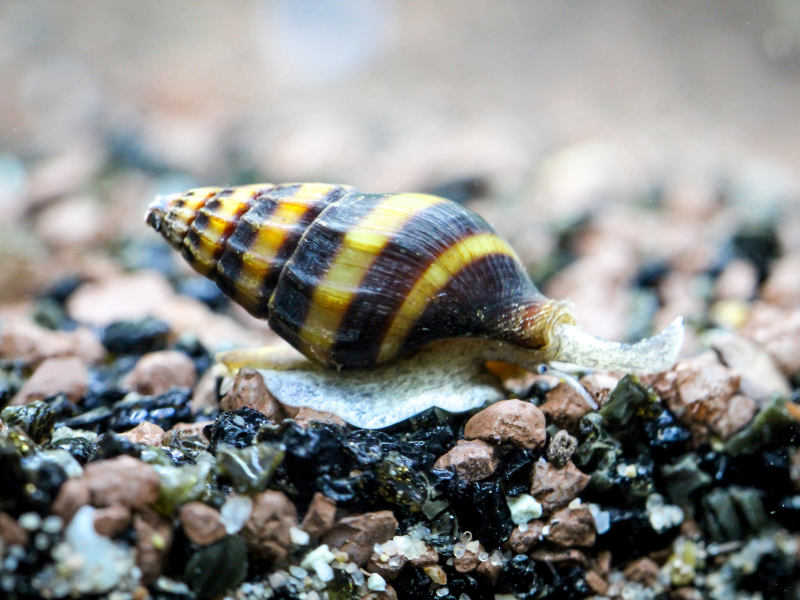Clea helena
Assassin Snail

Scientific Classification
Quick Stats
Aquarium Building Information
About This Species
Basic Description
Detailed Description
The Assassin Snail, originating from freshwater bodies in Asia, is a fascinating gastropod highly valued in the aquarium hobby for its predatory behavior. In its natural habitat, it thrives in environments with gentle water currents and soft, sandy, or muddy bottoms, which it uses for burrowing. Replicating this in an aquarium with a suitable substrate is key to observing its natural behaviors. These snails are active foragers that will spend a significant portion of their day buried, with just their siphon protruding, waiting to ambush prey or sense food in the water column.
As a dedicated carnivore, its primary function in many aquariums is the biological control of unwanted pest snails like Ramshorn, Bladder, and Malaysian Trumpet Snails. Its hunting method is direct; it will pursue and use its proboscis to consume its prey. When pest snails are eradicated, it is crucial to provide a consistent diet of protein-rich foods. Sinking carnivore pellets, wafers, frozen bloodworms, and brine shrimp are all excellent choices to ensure their nutritional needs are met. They are known to scavenge on deceased tank inhabitants and leftover fish food, contributing to the tank's cleanliness. Maintaining a small group is recommended, as they seem to exhibit more confident and active behavior when they can interact. Despite being predators, they are not a threat to aquarium fish, adult shrimp, or other invertebrates larger than themselves. Their metabolism is slow, and they produce minimal waste, making them a low-impact species in terms of bioload. This low bioload, combined with their hardiness, makes them suitable for a wide range of established freshwater community aquariums.
Scientific Description
Clea helena, a member of the family Nassariidae, is a freshwater gastropod mollusk native to Southeast Asia. Morphologically, it is characterized by its distinct fusiform or spindle-shaped shell, which is an adaptation that facilitates movement through soft substrates. This body shape is typical for many predatory gastropods. As a neogastropod, it possesses a well-developed siphon which it uses for chemoreception, allowing it to detect carrion and live prey from a distance. Its classification within Nassariidae is noteworthy, as most members of this family are marine scavengers, making C. helena one of the few that has adapted to a fully freshwater existence.
Ecologically, C. helena occupies the role of a benthic predator and scavenger. Its diet consists primarily of other gastropods and worms, but it will also consume detritus and carrion. This dietary preference makes it an effective biocontrol agent in artificial aquatic ecosystems (aquaria) for managing invasive snail populations. Physiologically, it exhibits a low metabolic rate and correspondingly low oxygen consumption, which allows it to thrive in stable, low-flow water conditions and endure periods of low food availability by burrowing and entering a state of reduced activity. Its adaptability is further demonstrated by its tolerance for a broad spectrum of water chemistry parameters. Its conservation status is currently listed as Least Concern by the IUCN, indicating that wild populations are stable and not facing immediate threats. Its low waste production results in a minimal bioload factor, making it an efficient organism within a closed aquatic system.
Breeding Description
Breeding Assassin Snails is considered moderately easy, as they reproduce at a slow, manageable rate without overrunning an aquarium. Unlike many prolific pest snails, this species is gonochoristic, meaning individuals are either male or female and both are required for reproduction. There are no reliable external differences to distinguish between the sexes, so acquiring a small group of at least three to five individuals is the best strategy to ensure a mix of males and females. Successful breeding is a sign of a healthy, stable aquarium environment with ample food.
During courtship and mating, the snails may lock together for many hours. Following successful fertilization, the female will deposit single, gelatinous, square-shaped egg capsules on hard surfaces throughout the aquarium, such as driftwood, plant leaves, or the tank glass. Each capsule contains a single egg. The incubation period is lengthy, often taking several weeks to a month or more depending on water temperature and other conditions. The process is slow, with only a few eggs being laid at a time. Upon hatching, a minuscule, fully-formed snail emerges and will typically burrow into the substrate immediately. These juvenile snails are self-sufficient, scavenging for microscopic organisms, detritus, and any available meaty foods they can find. A mature tank with a healthy substrate is beneficial for their early development. Due to their slow reproductive cycle and the slow growth of the young, their population is easily controlled, making them a desirable alternative to hermaphroditic, rapidly-multiplying snail species.
Generate Printable Card
Create a printable card for this creature to display in your store or aquarium. The card includes a QR code for quick access to more information.